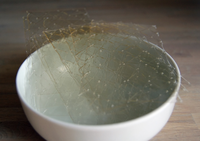
Photo from wikipedia
Regenerated cellulose obtained from sugarcane bagasse was used for hydrogel preparation using epichlorohydrin (crosslinker) and green zinc oxide nanoparticles (ZNPs) which were phytosynthesised from musk melon seed extract. The synthesised… Click to show full abstract
Regenerated cellulose obtained from sugarcane bagasse was used for hydrogel preparation using epichlorohydrin (crosslinker) and green zinc oxide nanoparticles (ZNPs) which were phytosynthesised from musk melon seed extract. The synthesised ZNPs were characterised using FESEM and EDAX. The swelling capacity of the hydrogel was determined by swelling measurements. For drug delivery studies from hydrogel, curcumin was selected as the model drug for its appealing anticancer and antimicrobial activity. The presence of ZNPs and curcumin in the hybrid hydrogel was analysed using FTIR, XRD, TGA and SEM analysis. The drug loading efficiency was optimised by Taguchi method. The drug release studies were performed under varying pH and initial drug loading concentration. The kinetic studies showed the best fit with case II type of transport with polymer swelling as the drug release mechanism. Antimicrobial activity for curcumin loaded hybrid hydrogel and pure cellulose hydrogel was performed using Staphylococcus aureus (bacteria) and Trichophyton rubrum (fungi). Thus, the developed curcumin loaded biomass derived hybrid hydrogel could find potential application towards skin infective applications.
Journal Title: Journal of Polymers and the Environment
Year Published: 2019
Link to full text (if available)
Share on Social Media: Sign Up to like & get
recommendations!